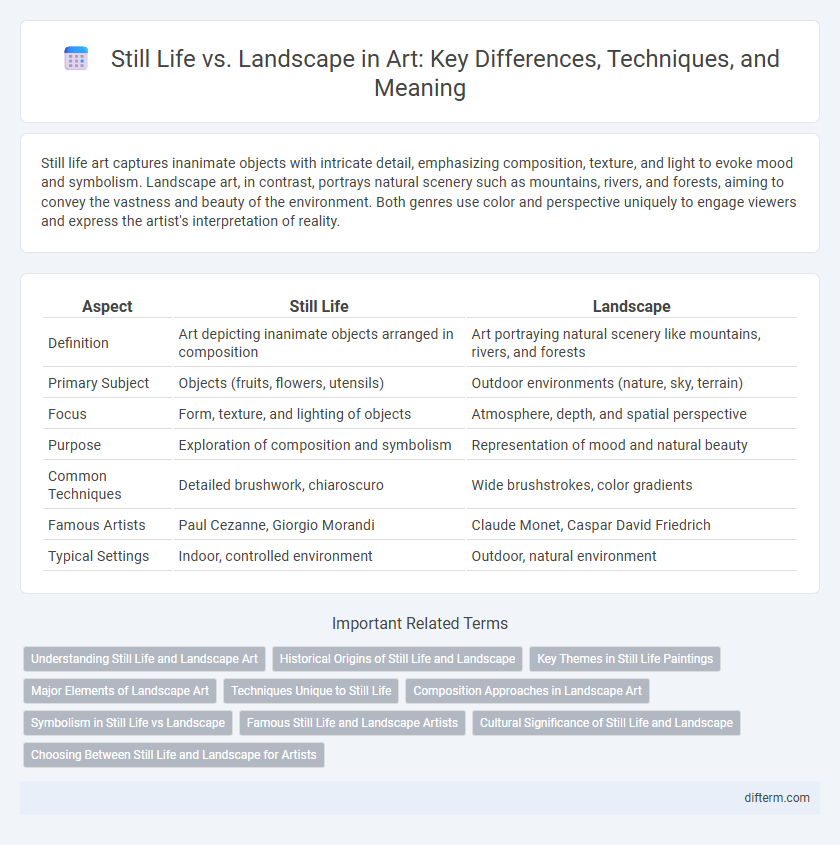Still life art captures inanimate objects with intricate detail, emphasizing composition, texture, and light to evoke mood and symbolism. Landscape art, in contrast, portrays natural scenery such as mountains, rivers, and forests, aiming to convey the vastness and beauty of the environment. Both genres use color and perspective uniquely to engage viewers and express the artist's interpretation of reality.
Table of Comparison
| Aspect | Still Life | Landscape |
|---|---|---|
| Definition | Art depicting inanimate objects arranged in composition | Art portraying natural scenery like mountains, rivers, and forests |
| Primary Subject | Objects (fruits, flowers, utensils) | Outdoor environments (nature, sky, terrain) |
| Focus | Form, texture, and lighting of objects | Atmosphere, depth, and spatial perspective |
| Purpose | Exploration of composition and symbolism | Representation of mood and natural beauty |
| Common Techniques | Detailed brushwork, chiaroscuro | Wide brushstrokes, color gradients |
| Famous Artists | Paul Cezanne, Giorgio Morandi | Claude Monet, Caspar David Friedrich |
| Typical Settings | Indoor, controlled environment | Outdoor, natural environment |
Understanding Still Life and Landscape Art
Still life art centers on the meticulous arrangement of inanimate objects, emphasizing texture, light, and composition to evoke mood and symbolism. Landscape art captures natural or urban environments, highlighting spatial depth, atmosphere, and the changing qualities of light to convey place and emotion. Mastery in both genres requires keen observation and an understanding of how elements like color, form, and perspective influence viewer perception.
Historical Origins of Still Life and Landscape
Still life painting traces its origins to ancient civilizations such as Egypt and Greece, where symbolic objects were depicted to convey meaning, evolving significantly during the Dutch Golden Age with artists like Pieter Claesz emphasizing realism and light. Landscape art emerged prominently in the Renaissance, with artists like Albrecht Durer and Leonardo da Vinci capturing natural scenery to explore perspective and atmospheric effects. Both genres reflect cultural and philosophical shifts, with still life focusing on materiality and transience, while landscape highlights the natural world's beauty and human interaction with the environment.
Key Themes in Still Life Paintings
Still life paintings emphasize themes of mortality, the passage of time, and the beauty found in everyday objects, often featuring symbolic elements like wilting flowers, hourglasses, or decaying fruit. These artworks explore texture, light, and composition to highlight the contrast between life and death, permanence and impermanence. By focusing on intimate, controlled scenes, still lifes invite viewers to contemplate existence and the material world on a personal level.
Major Elements of Landscape Art
Landscape art prominently features natural elements such as mountains, rivers, trees, and skies, emphasizing spatial depth through techniques like atmospheric perspective and horizon lines. Light and shadow play crucial roles in creating mood and realism, often highlighting textures of foliage and water surfaces. Composition balances foreground, middle ground, and background to guide the viewer's eye across the canvas, distinguishing it from the typically confined and focused arrangement found in still life artworks.
Techniques Unique to Still Life
Still life painting utilizes techniques like precise lighting, meticulous arrangement of objects, and attention to texture to create depth and realism. Artists often employ chiaroscuro to emphasize volume and contrast within confined compositions. Fine brushwork enhances surface details, distinguishing still life techniques from the broader, more dynamic strokes used in landscape art.
Composition Approaches in Landscape Art
Landscape art composition often employs techniques such as the rule of thirds, leading lines, and layering to create depth and guide the viewer's eye through expansive outdoor scenes. Unlike still life, which concentrates on the arrangement of inanimate objects within a confined space, landscape compositions balance natural elements like horizons, trees, and water bodies to evoke atmosphere and spatial relationships. Effective landscape composition integrates foreground, middle ground, and background elements to enhance perspective and visual harmony.
Symbolism in Still Life vs Landscape
Still life paintings often use symbolic objects like skulls, clocks, and fruit to convey themes of mortality, time, and abundance, reflecting deeper philosophical or moral messages. Landscape art typically symbolizes the natural world's beauty, power, and human connection to the environment through elements such as mountains, rivers, and weather patterns. While still life emphasizes intimate, personal symbolism tied to human experience, landscapes highlight broader, universal themes related to nature and existence.
Famous Still Life and Landscape Artists
Famous still life artists like Paul Cezanne and Giorgio Morandi revolutionized the genre by emphasizing form and subtle color variations, capturing everyday objects with profound depth. In landscape art, masters such as Claude Monet and J.M.W. Turner are renowned for their ability to depict natural scenes with dynamic light and atmospheric effects, shaping the Impressionist and Romantic movements. These artists' works highlight distinct approaches to subject matter, technique, and emotional expression within the broader art historical context.
Cultural Significance of Still Life and Landscape
Still life paintings emphasize cultural values and domestic life by capturing everyday objects, symbolizing themes of mortality, abundance, and the passage of time, reflecting societal beliefs and rituals. Landscape art highlights humanity's connection with nature, showcasing geographic identities and environmental changes that shape cultural heritage. Both genres provide unique insights into historical and social contexts, influencing artistic movements and cultural narratives globally.
Choosing Between Still Life and Landscape for Artists
Choosing between still life and landscape art depends on the artist's preference for subject matter and environment. Still life offers control over composition, lighting, and arrangement, ideal for exploring texture and detail in objects like fruits, flowers, and household items. Landscape painting requires capturing natural settings, weather conditions, and atmospheric effects, appealing to artists who enjoy outdoor scenes and dynamic light changes.
Still Life vs Landscape Infographic

 difterm.com
difterm.com